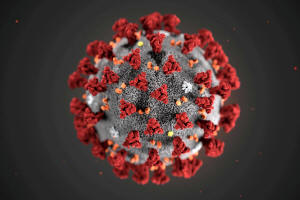Virus can damage brain without infecting it; hair loss on rise among
minorities during pandemic
 Send a link to a friend
Send a link to a friend
 [January 07, 2021]
By Nancy Lapid [January 07, 2021]
By Nancy Lapid
(Reuters) - The following is a roundup of
some of the latest scientific studies on the novel coronavirus and
efforts to find treatments and vaccines for COVID-19, the illness caused
by the virus.
Coronavirus can damage the brain without infecting it
The new coronavirus does not need to directly invade brain tissue to
damage it, a new study suggests. Researchers examined the brains of 19
patients who died from COVID-19, focusing on tissues from regions
thought to be highly susceptible to the virus: the olfactory bulb, which
controls the sense of smell, and the brainstem, which controls breathing
and heart rate. In 14 patients, one or both of these regions contained
damaged blood vessels - some clotted, and some leaking. The areas with
leakage were surrounded by inflammation from the body's immune response,
they found. But the researchers saw no signs of the virus itself, they
report in The New England Journal of Medicine. "We were completely
surprised," said coauthor Dr. Avindra Nath of the National Institute of
Neurological Disorders and Stroke in a statement. The damage his team
saw is usually associated with strokes and neuroinflammatory diseases,
he said. "So far, our results suggest that the damage ... may not have
been caused by the SARS-CoV-2 virus directly infecting the brain," Dr.
Nath said. "In the future, we plan to study how COVID-19 harms the
brain's blood vessels and whether that produces some of the short- and
long-term symptoms we see in patients."

Hair loss surges in NYC minority communities during pandemic
Pandemic stress may be causing people to lose their hair, according to a
new study. By mid-summer, rates of a hair-shedding condition called
telogen effluvium (TE) had surged more than 400% in a racially diverse
neighborhood in New York City, researchers report in the Journal of the
American Academy of Dermatology. From November 2019 through February
2020, the incidence of TE cases was 0.4%. By August, that rate had
climbed to 2.3%, they found. "It is unclear if the increase in cases of
TE is more closely related to the physiological toll of infection or
extreme emotional stress," said coauthor Dr. Shoshana Marmon of Coney
Island Hospital. The increase was due primarily to TE in persons of
color, particularly in the Hispanic community, "in line with the
disproportionately high mortality rate of this subset of the population
due to COVID-19 in NYC," the authors said. TE rates rose in smaller
non-white minorities as well, but not among Blacks, who also were
severely impacted by COVID-19. Dr. Adam Friedman of George Washington
School of Medicine and Health Sciences, who was not involved in the
research, said he too is seeing increases in TE "and the timing makes
plenty of sense, as the onset of shedding is typically three months
following the traumatic event," which would correspond to the rise of
the pandemic.
[to top of second column]
|

The ultrastructural morphology exhibited by the 2019 Novel
Coronavirus (2019-nCoV), is seen in an illustration released by the
Centers for Disease Control and Prevention (CDC) in Atlanta,
Georgia, U.S. January 29, 2020. Alissa Eckert, MS; Dan Higgins, MAM/CDC/Handout
via REUTERS.

Researchers argue for one vaccine dose to enhance supply
A single dose of one of the currently available COVID-19 vaccines,
even if less effective than two doses, may have greater population
benefit, three research groups argued on Tuesday in three papers in
Annals of Internal Medicine. In large trials, two-dose regimens of
the vaccine from Pfizer Inc and partner BioNTech SE and Moderna
Inc's shot both demonstrated nearly 95% efficacy in preventing
illness from the coronavirus. Yale School of Public Health
researchers say a less-effective single-dose might confer greater
population benefit than a 95%-effective vaccine requiring two doses.
University of Washington researchers say doubling vaccine coverage
by giving a single dose to more people would hasten pandemic control
by lowering transmission rates. Stanford University researchers say
delaying second doses in some people could enable millions more to
receive a vaccine. "In a public health emergency, a powerful
argument exists for doing something with less-than-perfect results
if it can help more persons quickly," said Thomas Bollyky of the
Council on Foreign Relations in an editorial published with the
papers. "However, whether alternative approaches with current
vaccines would accomplish this goal is far from clear." The U.S Food
and Drug Administration said on Monday the idea of changing the
authorized dosing or schedules of COVID-19 vaccines was premature
and not supported by available data.
(Reporting by Nancy Lapid and Marilynn Larkin; Editing by Bill
Berkrot)
[© 2021 Thomson Reuters. All rights
reserved.] Copyright 2021 Reuters. All rights reserved. This material may not be published,
broadcast, rewritten or redistributed.
Thompson Reuters is solely responsible for this content.
 |